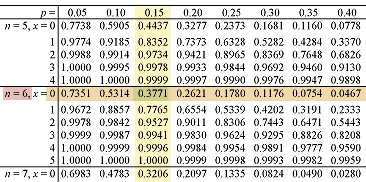Home >>STATISTICS, Section 2, binomial distribution 4
first principles |
First Principles
Cumulative probability tables - case of p>0.5
These give the tabulated value of P(X< x) . This means that the probability displayed is less than or equal to an observed value of x.
The random variable X is distributed Binomially, where there are n trials and probability of success p .
Working out values of random variable probabilty P(X) for the case of p>0.5 is complicated by the fact that values of p only go up to 0.5 .
The way around this problem is to consider another random variable Y , representing failure.
So we have: pX + pY = 1
In the same way as X, Y is distributed binomially:
Y ~ B(n,1 - pY)
Say that the random variable X has values X = 0, 1, 2, 3, 4, 5
A table of values for X (success) and Y (failure) looks like this:
X |
0 |
1 |
2 |
3 |
4 |
5 |
Y |
5 |
4 |
3 |
2 |
1 |
0 |
The method is to use the table to produce an expression in Y that will use values of p<0.5 .
The case P(X<x)
Say we wish to find the value of P(X<4) for :
X = 0, 1, 2, 3, 4, 5 pX=0.85* n=6
*tables only go up to 0.5
X (success) and Y (failure) are related so:
X |
0 |
1 |
2 |
3 |
4 |
5 |
Y |
5 |
4 |
3 |
2 |
1 |
0 |
The sum of successes and failures for each outcome must always be the same (ie 5).
The probability for Y becomes py=0.15* (pX + pY= 1)
* py <0.5 and therefore on the table
From the table,
P(X=0) + P(X=1) + P(X=2) + P(X=3) + P(X=4)
= P(Y=5) + P(Y=4) + P(Y=3) + P(Y=2) + P(Y=1)
this can be written:
P(X<4) = P(Y>1)
since,
P(Y=0) + P(Y=1) + P(Y=2) + P(Y=3) + P(Y=4) + P(Y=5) = 1
P(Y=1) + P(Y=2) + P(Y=3) + P(Y=4) + P(Y=5) = 1 - P(Y=0)
in other words,
P(Y>1) = 1 - P(Y<0)
hence the original inequality can be rewritten :
P(X<4) = 1 - P(Y<0)
Using the tables to find the value of P(Y<0) for n=6 pY=0.15 , Y=0 :
P(Y<0) = 0.3771

hence,
P(X<4) = 1 - 0.3771 = 0.6229
The case P(X=x)
Consider the binomial distribution for success,
X ~ B(n, pX)
X = 0, 1, 2, 3, 4, 5 pX=0.85 n=6
also the binomial distribution for failure,
Y ~ B(n, pY)
Y= 0, 1, 2, 3, 4, 5 pY=0.15 n=6
Say we want to find P(X=4).
X |
0 |
1 |
2 |
3 |
4 |
5 |
Y |
5 |
4 |
3 |
2 |
1 |
0 |
From the table it follows that,
P(X=4) = P(Y=1)
P(Y=1) = P(Y<1) - P(Y<0)
P(X=4) = P(Y<1) - P(Y<0)
P(X=4) = 0.7765 - 0.3771 = 0.3994
The case P(X<x)
Consider the binomial distribution for success,
X ~ B(n, pX)
X = 0, 1, 2, 3, 4, 5 pX=0.85 n=6
also the binomial distribution for failure,
Y ~ B(n, pY)
Y= 0, 1, 2, 3, 4, 5 pY=0.15 n=6
Say we want to find P(X<4).
X |
0 |
1 |
2 |
3 |
4 |
5 |
Y |
5 |
4 |
3 |
2 |
1 |
0 |
From the table it follows that,
P(X<4) = P(Y>1)
and
P(Y>1) = P(Y=2) + P(Y=3) + P(Y=4) + P(Y=5)
it follows that,
P(Y>1) = P(Y>2)
P(Y>2) = P(Y=2) + P(Y=3) + P(Y=4) + P(Y=5)
P(Y=0) + P(Y=1) + P(Y=2) + P(Y=3) + P(Y=4) + P(Y=5) = 1
P(Y=2) + P(Y=3) + P(Y=4) + P(Y=5) = 1 - [ P(Y=0) + P(Y=1)]
P(Y>2) = 1 - [ P(Y=0) + P(Y=1)]
P(Y>2) = 1 - P(Y<1)
P(X<4) = 1 - P(Y<1)
P(X<4) = 1 - 0.7765 = 0.2235
The case P(X>x)
Consider the binomial distribution for success,
X ~ B(n, pX)
X = 0, 1, 2, 3, 4, 5 pX=0.85 n=6
also the binomial distribution for failure,
Y ~ B(n, pY)
Y = 0, 1, 2, 3, 4, 5 pY=0.15 n=6
Say we want to find P(X>4).
X |
0 |
1 |
2 |
3 |
4 |
5 |
Y |
5 |
4 |
3 |
2 |
1 |
0 |
P(X>4) = P(Y<1)
P(Y<1) = P(Y=0)
P(Y=0) = P(Y<0)
P(X>4) = P(Y<0)
reading P(Y<0) directly from the tables,
P(X>4) = 0.3771
The case P(X>x)
Consider the binomial distribution for success,
X ~ B(n, pX)
X = 0, 1, 2, 3, 4, 5 pX=0.85 n=6
also the binomial distribution for failure,
Y ~ B(n, pY)
Y = 0, 1, 2, 3, 4, 5 pY=0.15 n=6
Say we want to find P(X>4).
X |
0 |
1 |
2 |
3 |
4 |
5 |
Y |
5 |
4 |
3 |
2 |
1 |
0 |
P(X>4) = P(Y<1)
reading P(Y<1) directly from the tables,
P(X>4) = 0.7765
[ About ] [ FAQ ] [ Links ] [ Terms & Conditions ] [ Privacy ] [ Site Map ] [ Contact ]
